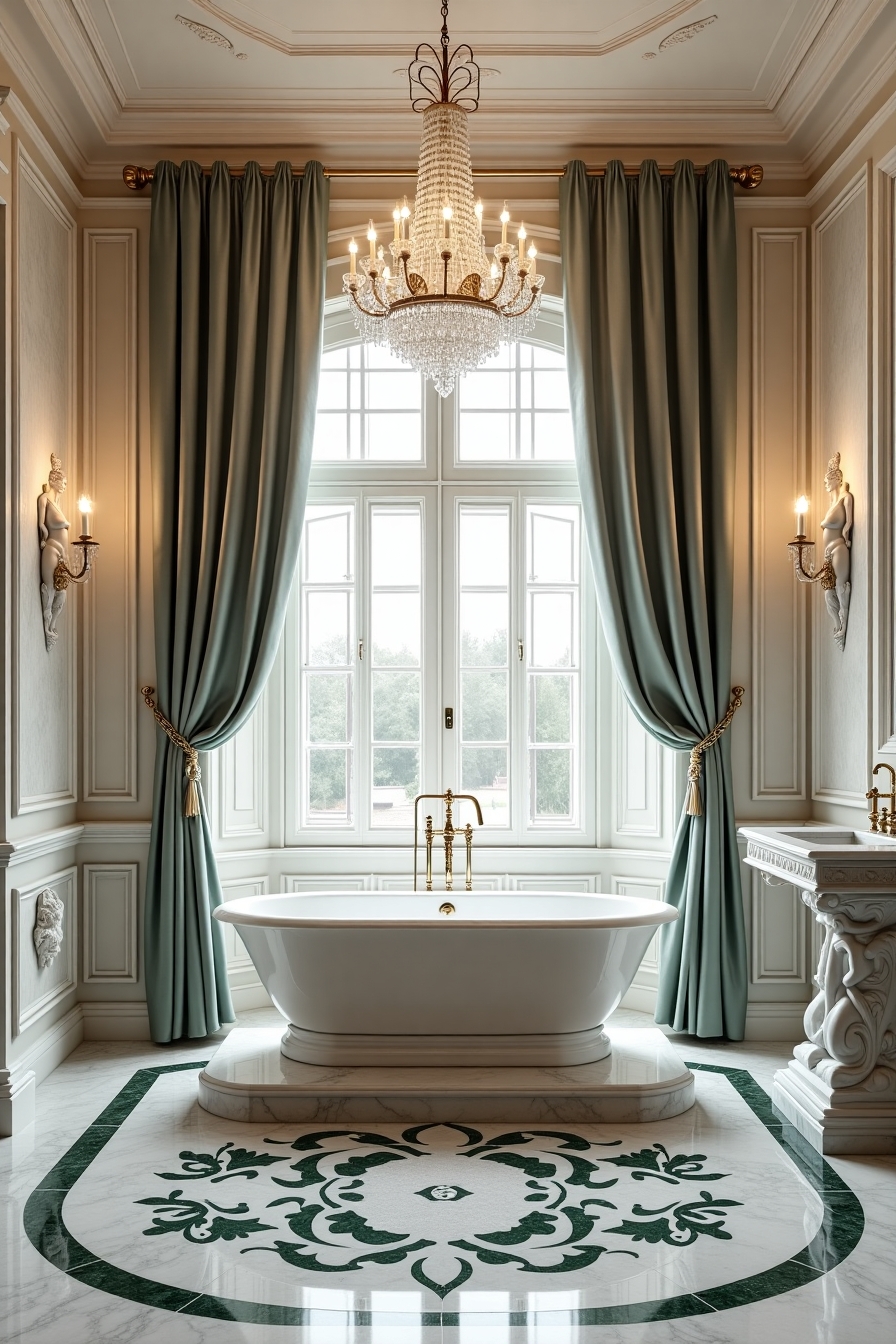French bathroom design captures an elusive quality that balances elegance with comfort, luxury with livability.
The allure of stepping into a centuries-old Parisian apartment bathroom—where marble surfaces catch morning light, clawfoot tubs position perfectly beneath windows overlooking historic rooftops, and fixtures resemble jewelry rather than mere plumbing—creates an immediate and lasting impression.
There’s something magical about the way cool brass taps develop a patina over decades, telling stories of the hands that have touched them and the lives lived within those walls.
French bathrooms possess that indefinable quality that transcends mere decoration to create spaces that feel both timelessly elegant and effortlessly sophisticated.
The essence of French bathroom design lies in this perfect balance—embracing both formal architectural elements and casual lived-in comfort, celebrating both old-world craftsmanship and practical modern conveniences.
✨Click to Get My 101 FREE Designer Room Ideas
The Iconic Clawfoot Tub: The Crown Jewel of French Bathrooms


Nothing says French bathroom luxury quite like a classic clawfoot tub taking center stage.
These freestanding showstoppers instantly elevate any bathroom from ordinary to extraordinary with their timeless silhouette and old-world charm.
For authentic French appeal, look for a vintage tub with ornate feet in brass or aged bronze finishes.
Modern reproductions offer the same visual impact with updated materials that are often lighter and more durable than traditional cast iron.
Place your tub near a window to create a dreamy bathing experience where you can soak while gazing out at the garden or skyline.
For a truly luxurious statement, consider a double-ended design that features gentle slopes on both sides, perfect for reclining in either direction.
White remains the most popular and versatile color choice, but don’t shy away from painted exteriors in soft blues, sage greens, or even dramatic black for a contemporary twist on French elegance.
Complement your tub with vintage-inspired fixtures, including a telephone-style faucet and handheld shower attachment in brushed brass or polished nickel.
Add a wooden bath caddy across the tub to hold your essential bathing accessories, a glass of wine, or your favorite book.
For practical considerations, ensure your floor can support the weight of a cast iron tub, or opt for lighter acrylic alternatives that offer similar aesthetics.
The magic of a clawfoot tub lies in its ability to serve as both a functional bathing spot and a sculptural focal point that anchors your bathroom’s design.
Position a small accent table within arm’s reach of your tub, topped with scented candles, bath salts, and plush hand towels for the ultimate bathing ritual.
Even in smaller bathrooms, a compact clawfoot tub can create maximum impact—consider a 54″ or 60″ model that delivers the French aesthetic without overwhelming the space.
Vintage-Inspired Fixtures: Elegant Hardware With Historical Character


French bathroom design celebrates the beauty of thoughtfully crafted fixtures that feel like jewelry for your space.
Opt for faucets, handles, and hardware with intricate detailing that capture the essence of French craftsmanship.
Unlacquered brass fixtures develop a living patina over time, creating that perfectly imperfect look that defines authentic French interiors.
Cross-handle faucets with porcelain inlays offer both ergonomic functionality and period-appropriate style for your sink and tub.
Look for exposed plumbing elements with decorative traps and supply lines that transform utilitarian necessities into design features.
Wall-mounted fixtures save precious counter space while adding architectural interest through their unexpected placement.
For shower systems, choose exposed thermostatic valves with oversized rain shower heads to create a luxurious bathing experience reminiscent of high-end French hotels.
Towel warmers with ornate scrollwork serve dual purposes as both functional elements and decorative accents that enhance your bathroom’s design language.
When selecting cabinet hardware, consider drop pulls or ornate knobs in aged brass, antique silver, or oil-rubbed bronze to complete the French-inspired look.
Mixing metal finishes—like combining warm brass with cool nickel—creates depth and interest that feels collected over time rather than purchased all at once.
For authentic character, scout antique stores, architectural salvage shops, or online marketplaces for genuine vintage fixtures that can be restored and retrofitted.
Modern reproductions from specialty manufacturers offer historical accuracy with updated internal components that meet contemporary efficiency standards.
Remember that hardware is where craftsmanship truly shines—invest in quality pieces that feel substantial in your hand and operate with satisfying mechanical precision.
Fixture placement should follow both ergonomic logic and visual harmony, creating a rhythmic flow as you move through your daily routines.
The Perfect Palette: Soft, Sophisticated French Color Schemes

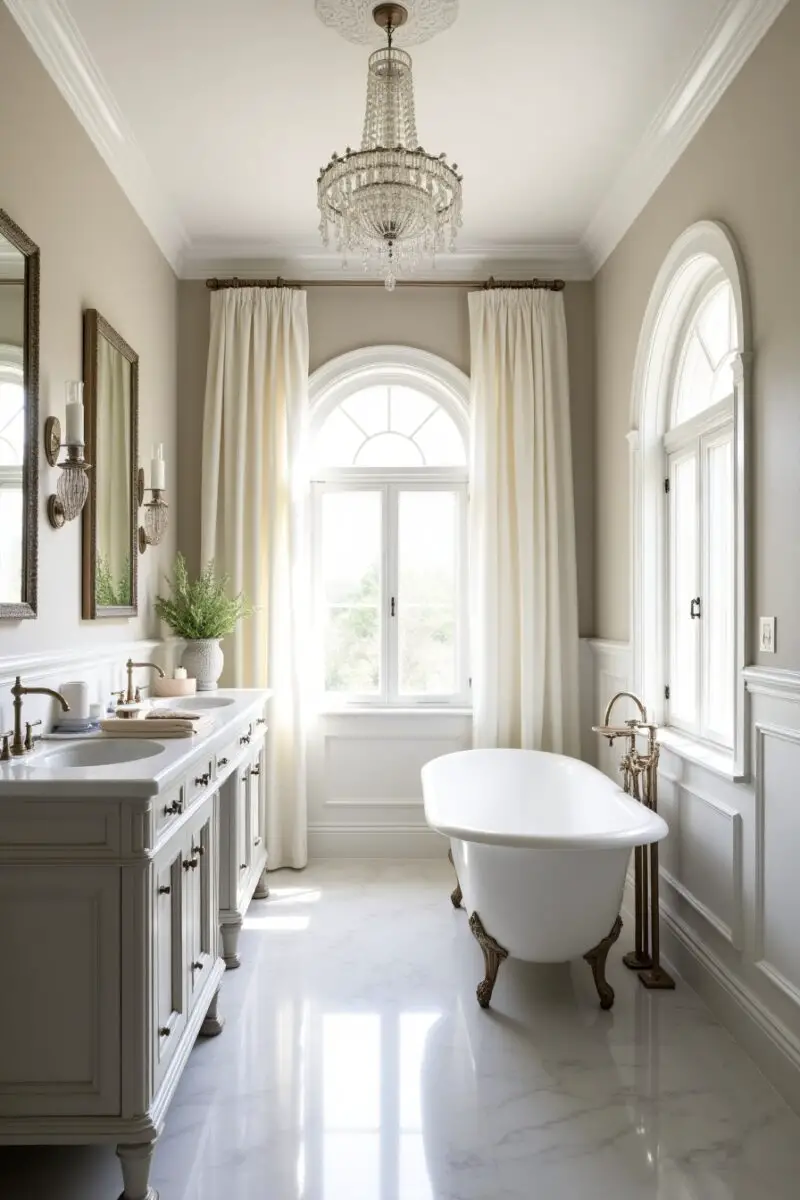
French bathroom color palettes draw inspiration from both the sun-drenched countryside and the sophisticated urbanity of Paris.
Soft, muted tones create the foundation for a truly French aesthetic that feels both timeless and soothing.
Consider walls in creamy ivory, soft dove gray, or pale blue-gray that reference the misty morning light over the Seine.
Whites are rarely stark in French design—instead, look for warm whites with subtle undertones that create depth and nuance as the light changes throughout the day.
Pale blush tones add warmth without feeling overtly feminine, creating an inviting atmosphere that flatters skin tones.
For a more dramatic interpretation, deep navy, charcoal, or aubergine can create sophisticated drama while maintaining the French sensibility when balanced with light elements.
French provincial bathrooms might incorporate sage green, lavender, or buttery yellow inspired by the natural landscape of the countryside.
Whatever base color you choose, ensure it has a slightly muted quality—French colors are rarely primary or overly saturated, instead appearing gently filtered through Parisian light.
Consider using lime wash or mineral-based paints that create subtle texture and depth on walls, avoiding flat, lifeless finishes that feel contemporary rather than timeless.
Trims and moldings traditionally appear in contrasting whites or creams to highlight architectural details.
For a truly authentic look, incorporate patina and gentle aging into your color strategy—perfect freshness feels too new for a space that should feel lived-in and evolved.
Color isn’t just for walls—consider painted furniture in complementary tones that add layers of visual interest to your space.
Ceilings deserve special attention in French design—consider pale blue, soft green, or even a wash of the wall color at reduced strength to create a cohesive envelope.
Remember that natural materials like marble, limestone, and wood contribute to your color story through their inherent variations and undertones.
Statement Tile Work: The Art of French Patterns and Placement

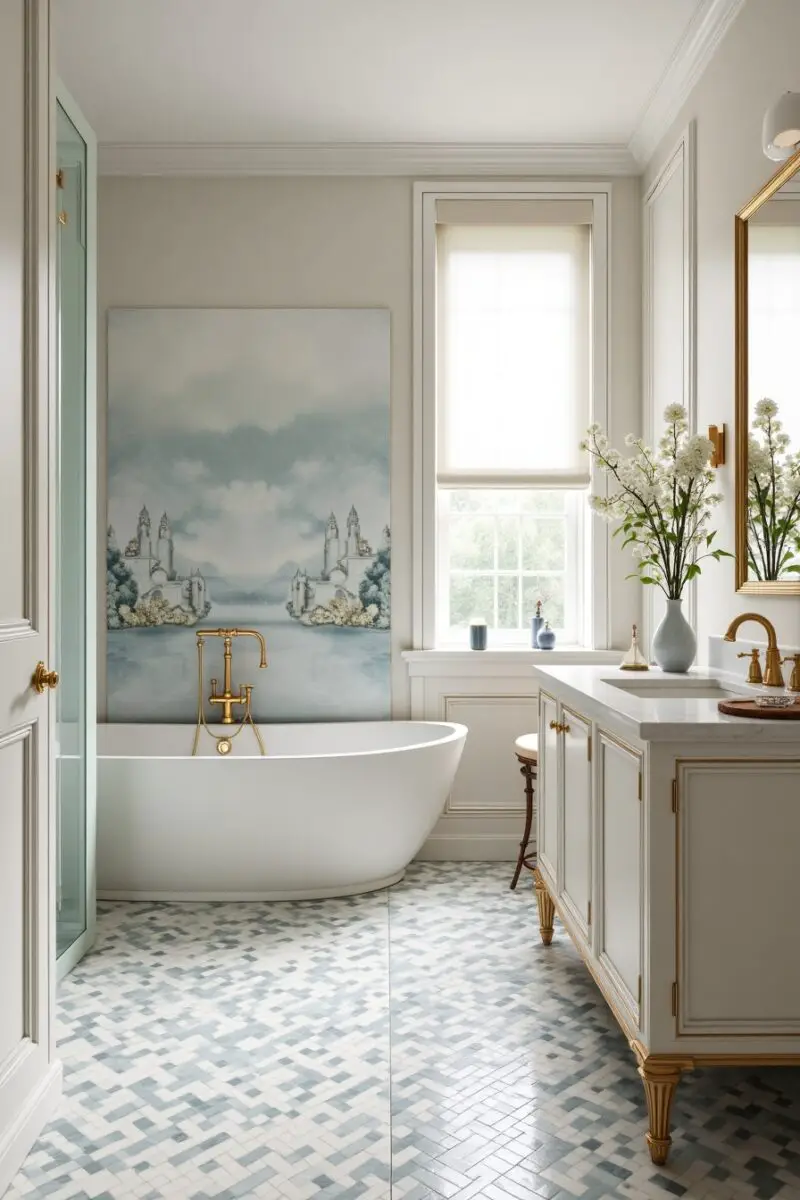
French bathrooms elevate tile from mere surface covering to artistic expression through thoughtful pattern work and unexpected applications.
Hexagonal tiles in marble or porcelain create a classic French foundation that feels both historic and timeless.
Consider traditional terracotta tiles with a matte finish for instant warmth and authentic old-world character reminiscent of Provençal farmhouses.
Zellige tiles, with their handmade quality and subtle color variations, capture the imperfect beauty central to French design philosophy.
Metro tiles—the rectangular subway tiles that line Paris Métro stations—offer urban French flair when installed in unexpected patterns like herringbone or basketweave.
For true French elegance, marble basketweave or checkerboard patterns in contrasting stones create sophisticated floors that anchor the entire design.
Don’t limit patterns to floors—French bathrooms often feature tile wainscoting that protects walls while adding decorative interest up to chair rail height.
Create visual hierarchy by using more elaborate patterns in one area (like floors) while keeping other surfaces simple, allowing each element to shine without competition.
Consider encaustic cement tiles with their rich patterns and colors for a statement floor that serves as the room’s artistic centerpiece.
Scale matters in French tile applications—tiny mosaics feel appropriately delicate for shower floors, while larger format tiles create calm on main wall surfaces.
For authentic French country charm, look for hand-painted ceramic tiles featuring traditional motifs like fleur-de-lis, trailing vines, or provincial scenes in blue and yellow.
In more formal Parisian-inspired bathrooms, geometric marble inlays and borders reference the grand palaces and museums of France’s architectural history.
When working with patterned tiles, create intentional “frames” using solid border tiles to contain and highlight the decorative elements.
Remember that grout color dramatically impacts the final look—light grout emphasizes each individual tile, while darker grout recedes to highlight the overall pattern.
✨Click to Get My 101 FREE Designer Room Ideas
Illuminating Elegance: Distinctive French Lighting Solutions


Lighting in French bathrooms balances practical illumination with theatrical ambiance that transforms ordinary spaces into extraordinary experiences.
A crystal chandelier suspended over a freestanding tub creates an unexpectedly glamorous focal point that defines French bathroom luxury.
Wall sconces with fabric shades positioned at eye level provide the most flattering light for grooming tasks while adding decorative charm.
Consider brass picture lights mounted above mirrors or artwork for a sophisticated approach that references library and gallery lighting.
Authentic French bathrooms often combine multiple light sources at different heights to create layers of illumination that can be adjusted throughout the day.
Look for fixtures with historical references—like glass bell jars, lantern shapes, or candle-style sconces—that connect to France’s rich design heritage.
For a countryside French look, simple iron fixtures with clean lines provide beautiful contrast against softer furnishings and finishes.
Embracing asymmetry in lighting placement feels authentically French—consider a striking pendant on one side of a vanity paired with a complementary but not matching sconce on the opposite wall.
Remember that the quality of light matters as much as the fixture design—opt for warm-toned bulbs (2700-3000K) that flatter skin tones and enhance natural materials.
French design appreciates the beauty of exposed bulbs in certain applications—consider vintage-style Edison bulbs in simple sockets for industrial-inspired Parisian charm.
Integrate lighting into architectural elements by installing LED strips beneath floating vanities or behind mirrors for a modern interpretation of French ambiance.
Don’t overlook natural light—sheer window treatments that filter sunlight create that magical, diffused illumination seen in classic French interiors.
Consider the shadows created by your lighting choices—strategic placement can highlight textures and architectural details that might otherwise go unnoticed.
For nighttime luxury, install dimmers on all lighting circuits to create the perfect atmospheric glow for evening baths and relaxation.
Mirrors With Character: Reflective Statements of French Style


Mirrors in French bathrooms go far beyond functional reflective surfaces to become artistic focal points that expand space and reflect light.
Seek out antique French trumeau mirrors with painted panels above the mirror portion for an instantly authentic architectural element.
Gilded frames with elaborate carvings reference the ornate beauty of Versailles while adding warmth through their golden tones.
For a more rustic French country approach, consider weathered wooden frames with subtle distressing that suggests generations of use.
Oval mirrors with delicately carved frames offer a softer alternative to rectangular shapes and feel inherently French in their elegant proportions.
Don’t hesitate to go oversized—French design often incorporates unexpectedly large mirrors that create dramatic impact while visually doubling the space.
Consider the patina of your mirror’s reflective surface—authentic French style often embraces the softened reflection of antique mirror glass with its gentle spotting and foxing.
For a collected, evolving look, group smaller mirrors in complementary frames to create a gallery wall effect that feels curated over time.
Placement matters—position mirrors to reflect your bathroom’s most beautiful features, whether that’s a statement chandelier, garden window, or clawfoot tub.
Tilt-able mirrors mounted on adjustable brass arms provide practical functionality while adding an element of industrial Parisian style.
For unexpected French flair, consider a mirrored cabinet with antiqued panels and delicate hardware that provides storage without sacrificing style.
Incorporate architectural elements by flanking your mirror with sconces or decorative molding that frames the reflection like a piece of art.
Remember that mirrors need not be hung flat against the wall—leaning a substantial floor mirror against the wall creates casual elegance with a touch of deliberate nonchalance.
For bathrooms with limited natural light, strategically placed mirrors can capture and redirect sunlight to brighten dark corners.
Vanity Affairs: Distinctive French Cabinetry Solutions


French bathroom vanities eschew built-in monotony in favor of freestanding furniture pieces that bring character and history to the space.
Consider repurposing an antique commode or buffet by adapting it with a vessel sink and plumbing to create a one-of-a-kind vanity with authentic patina.
For genuine French provincial style, look for cabinets with scalloped aprons, cabriole legs, and curved fronts that soften the utilitarian nature of bathroom storage.
Painted finishes in chalky blues, greens, or creams with subtle distressing capture the evolved quality of French furniture that’s been lovingly used for generations.
Hardware makes a significant impact—seek out aged brass bin pulls, glass knobs with brass backplates, or decorative bail handles that add jewelry-like detail.
Open shelving beneath a countertop creates breathing space in smaller bathrooms while offering convenient storage for towels arranged in casual, artful stacks.
Marble countertops with ogee or bullnose edges feel appropriately luxurious while developing character through natural etching and patina over time.
Consider a furniture-style vanity with turned legs and an open bottom that creates a lighter visual footprint while showcasing beautiful flooring beneath.
For double vanities, French design often pairs matching sinks with different cabinetry pieces that coordinate rather than match exactly, creating a collected rather than manufactured look.
Integrate unexpected elements like antique metal table bases topped with stone slabs for an industrial Parisian approach to vanity design.
Don’t overlook the interior organization—small drawers with dividers for cosmetics and personal items reflect the French appreciation for thoughtful, precise storage solutions.
In smaller spaces, wall-mounted sinks with exposed plumbing and a small cabinet nearby offer functional compromise without sacrificing style.
For true luxury, incorporate a seated vanity area with a low stool or chair where one can comfortably attend to personal grooming in leisurely French fashion.
Remember that perfect symmetry often feels too contrived for authentic French design—embrace the character that comes from slight irregularities and adaptations.
Textile Touches: Curtains, and Fabric Accents
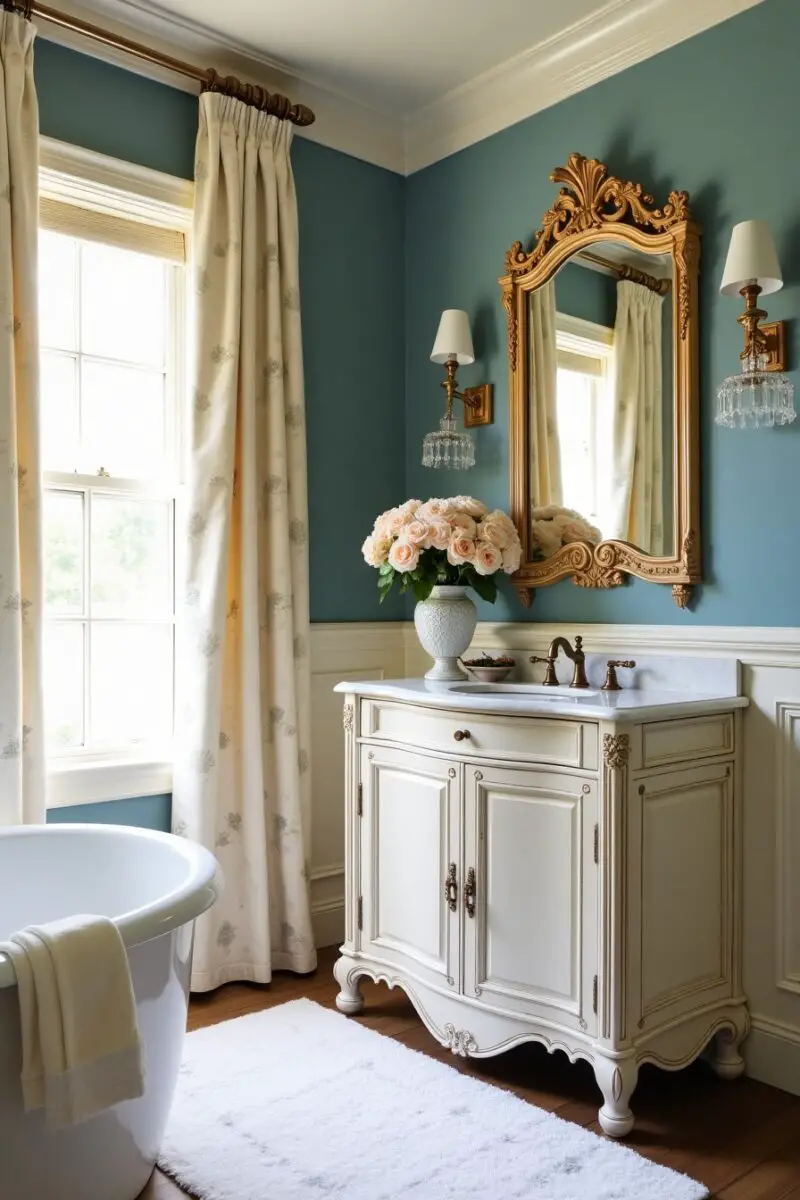

Textiles in French bathrooms soften hard surfaces and add crucial layers of texture, pattern, and personal comfort to create truly inviting spaces.
High-quality cotton or linen towels in muted tones with simple monograms or embroidered details epitomize French bathroom luxury.
Consider eschewing traditional bath mats in favor of vintage wool rugs that add unexpected warmth, color, and pattern to bathroom floors.
Window treatments should balance privacy with light—café curtains that cover only the lower portion of windows offer an ideal compromise with authentic French charm.
For shower curtains, look beyond plastic to washable linen or cotton canvas in simple stripes, toile patterns, or solid colors with decorative trim.
French bathrooms often feature upholstered elements—consider a small slipper chair or upholstered stool that invites lingering and turns routine into ritual.
Towel storage becomes a design feature when stacks of neatly folded linens in complementary colors are displayed on open shelves or in glass-fronted cabinets.
For pattern, classic French toile de Jouy with its scenic vignettes brings narrative and historical reference to bathroom textiles.
Simple ticking stripes in blue, red, or tan offer understated pattern that references French mattress coverings and kitchen linens.
Don’t overlook the tactile quality of your textiles—French design prioritizes how things feel as much as how they look, so invest in materials with substantial weight and natural texture.
Consider a fabric skirt beneath a pedestal sink or around a floating vanity to add softness and conceal storage while referencing traditional French furniture coverings.
For a cohesive look, coordinate your textile choices with restraint—perhaps limiting yourself to three complementary patterns in a consistent color palette.
Remember that authentic French spaces evolve over time—incorporate vintage textiles like hand-embroidered guest towels or antique linen sheets repurposed as curtains.
Embrace the beautiful imperfection of natural fibers—linen’s tendency to wrinkle and cotton’s gentle fading add to rather than detract from French bathroom authenticity.
✨Click to Get My 101 FREE Designer Room Ideas
Floor Statements: Herringbone, Parquet, and Traditional Patterns
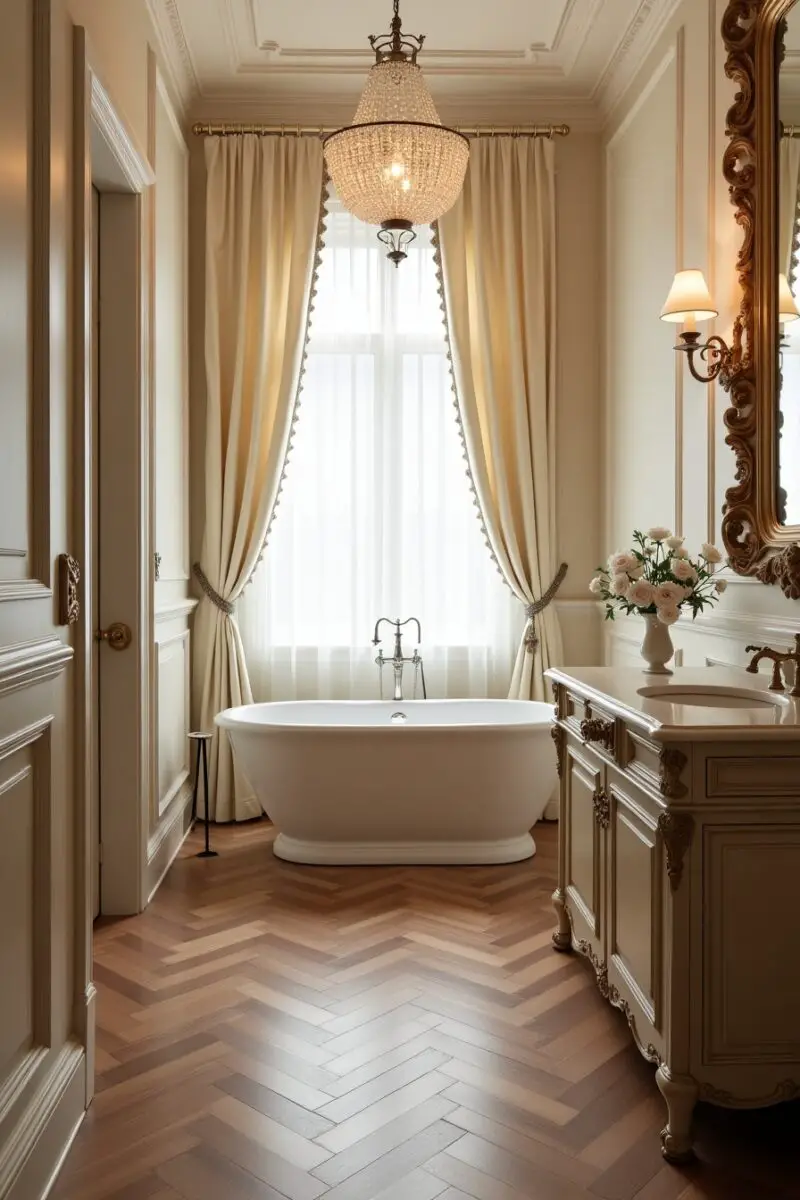
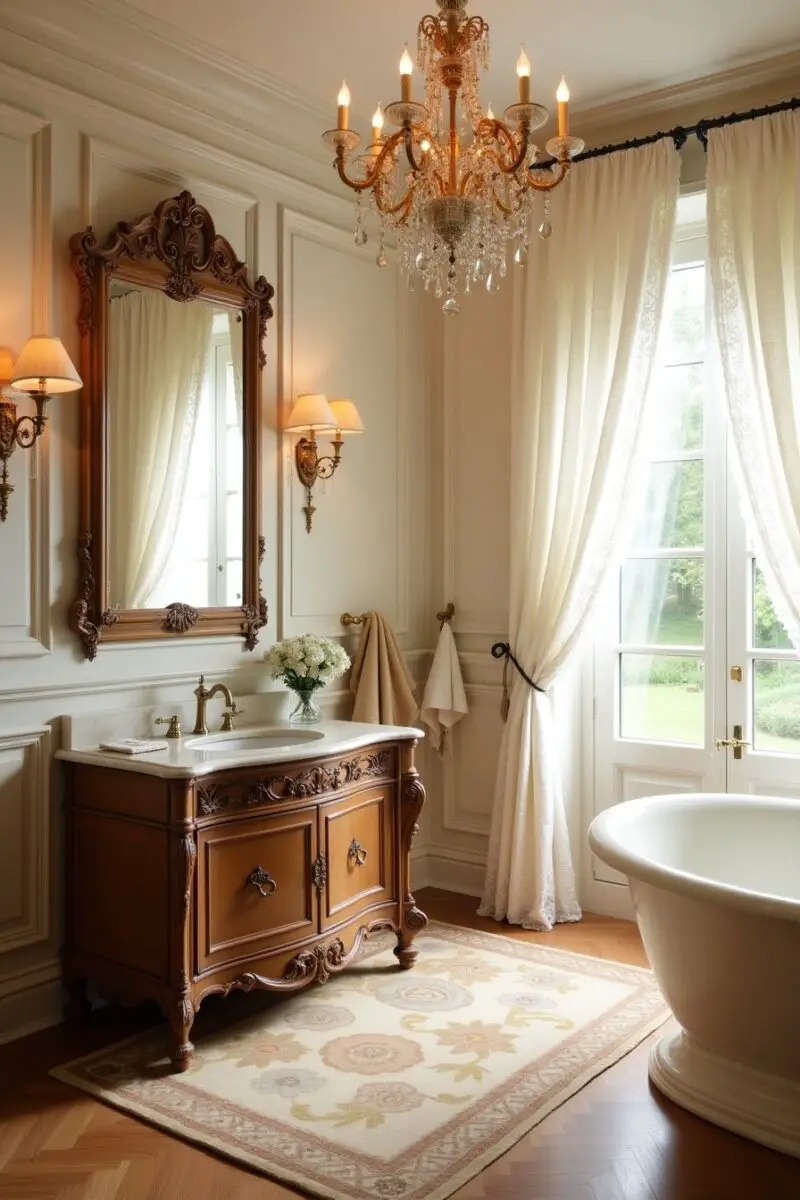
French bathroom floors provide the foundation for the entire design with patterns and materials that reference centuries of architectural tradition.
Herringbone wood floors create instant French atmosphere with their distinctive zigzag pattern that adds movement and sophistication.
For authentic character, consider reclaimed oak parquet de Versailles or point de Hongrie patterns that bring historical gravitas to contemporary spaces.
In smaller bathrooms, continuing the same flooring from adjacent spaces creates flow and expands the perceived size of the room.
Marble checkerboard floors in black and white or more subtle combinations like Carrara and Bardiglio create timeless elegance reminiscent of grand Parisian apartments.
For practicality in wet areas, consider porcelain tiles that convincingly mimic natural materials while offering superior water resistance and maintenance.
Encaustic cement tiles in geometric patterns or floral motifs reference both French Morocco and the historic buildings of Paris with their vibrant patterns and colors.
Consider borders and feature insets that frame different functional zones, creating room-within-room effects that add architectural definition.
Heated floors beneath stone or tile offer luxurious comfort during winter months while maintaining authentic materials and appearances.
For French country bathrooms, consider terracotta tiles in warm honey tones that develop beautiful patina with age and use.
Remember scale when selecting patterned floors—smaller spaces often benefit from smaller pattern repeats that don’t overwhelm the room’s proportions.
Don’t overlook the importance of transitions between rooms—thoughtful thresholds and borders help define spaces while maintaining visual flow.
In period renovations, search for authentic reclaimed materials when possible—the subtle variations in color and wear of original floors cannot be perfectly replicated.
Consider the practical aspects of your flooring choice—ensure materials are properly sealed and maintained to withstand bathroom humidity and water exposure.
Marble Moments: Luxurious Stone Applications


Marble in French bathrooms transcends mere luxury to become the defining element that communicates timeless elegance and refined taste.
Carrara marble with its soft gray veining on a white background remains the quintessential choice for authentic French bathroom surfaces.
Consider book-matched marble slabs for shower walls where the natural veining creates mirror-image patterns that feel like abstract art.
For countertops, opt for honed rather than polished finishes that develop patina gracefully while providing subtle texture underhand.
Embrace the natural aging process of marble—the slight etching and wear that develops over time tells the story of a well-loved and genuinely used space.
Mix marble varieties for visual interest—perhaps Carrara countertops with Bardiglio shower bases or Calacatta Gold accents for warm contrast.
For budget-conscious renovations, consider marble threshold strips, corner shelves, or soap dishes that add touches of luxury without the expense of full marble surfaces.
Remember that marble is naturally cool to the touch—a delightful sensory experience during warm weather months but potentially shocking in winter unless paired with heated floors.
Marble mosaics in basket weave, hexagon, or penny round patterns create intricate floors that reference historic French bathrooms from the Belle Époque.
Consider unexpected applications like marble baseboards, window sills, or built-in niches that integrate stone in surprising and delightful ways.
For maintenance, embrace the wabi-sabi philosophy—natural marble develops character through use that enhances rather than diminishes its beauty.
In contemporary interpretations of French bathrooms, large-format marble tiles with minimal grout lines create clean, modern surfaces while maintaining traditional materials.
Don’t overlook marble alternatives like quartzite or porcelain that offer similar aesthetics with different performance characteristics for specific applications.
Remember that the French approach values quality over quantity—even small applications of exceptional marble make more impact than extensive use of inferior materials.
Apothecary Accents: Vintage-Inspired Storage and Display

French bathrooms elevate everyday essentials through thoughtfully curated storage solutions that reference historical pharmacy and perfumery traditions.
Glass canisters with ground glass stoppers display bath salts, cotton balls, and other necessities as decorative elements rather than items to hide away.
Consider antique pharmacy bottles in amber or cobalt blue glass to store mouthwash, lotions, or liquid soaps with authentic vintage appeal.
Silver or ceramic trays corral perfume bottles and daily essentials on countertops, transforming utilitarian items into artistic arrangements.
Look for vintage hotel silver soap dishes, toothbrush holders, and cups that develop beautiful patina while serving practical functions.
Open shelving displaying neatly arranged white towels alongside glass containers creates the organized yet accessible feeling of a luxury hotel.
Wicker or rattan baskets add natural texture while providing pragmatic storage for larger items like extra toilet paper or clean towels.
For personal products you’d rather not display, consider repurposing vintage suitcases, hat boxes, or metal tins that add character while concealing modern necessities.
Embrace labeled storage with handwritten or printed tags on jars and baskets—functional organization becomes part of the aesthetic when thoughtfully executed.
Consider a vintage rolling cart that can be moved where needed, offering flexible storage that references French hotel service carts.
Look for authentic pharmaceutical or perfumery pieces at flea markets—glass-fronted cabinets, sorting trays, or dispensing containers that bring genuine history to your space.
Wall-mounted cup racks holding vintage glasses or modern tumblers provide convenient toothbrush storage with French bistro charm.
Remember that in French design, the everyday becomes extraordinary through thoughtful presentation—even humble cotton swabs gain elegance when stored in a crystal compote.
For larger storage needs, consider armoires or linen presses that bring furniture-quality presence to the bathroom while providing substantial hidden storage.
Wall Treatments: Paneling, Paper, and Painted Effects

French bathroom walls offer opportunities for dramatic expression through treatments that add depth, texture, and visual interest beyond basic paint.
Consider traditional boiserie (wood paneling) painted in glossy white or cream for instant architectural gravitas in any bathroom.
For a simplified approach, picture frame molding applied in geometric patterns creates the effect of paneling without the expense or complexity of full wood installation.
Wallpaper makes a triumphant statement in French bathrooms—look for toile patterns depicting pastoral scenes in classic blue and white or more unexpected color combinations.
For moisture-prone areas, consider vinyl wallcoverings with traditional French patterns that offer practical durability with authentic visual appeal.
Hand-painted murals depicting garden scenes, trompe l’oeil architectural elements, or grisaille landscapes create one-of-a-kind wall treatments with old-world charm.
Don’t hesitate to paper or panel all walls including the ceiling for a fully enveloping jewel-box effect that feels luxuriously French.
For subtle texture, consider Venetian plaster finishes that create depth and luminosity as light plays across their irregularly burnished surfaces.
Mix wall treatments strategically—perhaps wallpaper above wainscoting, decorative paneling in water closets, and painted walls in shower areas.
In French country bathrooms, consider whitewashed shiplap or beadboard that references rural architectural traditions while providing practical water resistance.
For a truly authentic touch, lime wash paint creates subtle variations in color and texture that capture the indefinable depth of walls in historic French buildings.
Remember scale when selecting patterned wallcoverings—larger patterns often work surprisingly well in smaller spaces, creating expansive visual interest.
Consider borders, friezes, and picture rails that divide walls into proportional sections while adding decorative detail at transitions.
Don’t overlook the fifth wall—ceilings painted in pale blue, adorned with delicate patterns, or finished with metallic glazes add unexpected delight as you relax in the tub.
✨Click to Get My 101 FREE Designer Room Ideas
Space-Maximizing French Design: Solutions for Bathrooms Large and Small


French bathroom design offers ingenious approaches to space utilization that balance functionality with beauty regardless of room dimensions.
Consider a petite clawfoot tub measuring just 48″ or 54″ long that delivers French style without overwhelming smaller bathrooms.
Wall-mounted fixtures and floating vanities create visual space by revealing more floor area, a technique borrowed from space-conscious Parisian apartments.
Mirrors strategically placed to reflect windows or interesting architectural features effectively double the perceived dimensions of the room.
For storage challenges, look upward—French bathrooms often utilize vertical space with tall, narrow cabinets or shelving that maximize limited square footage.
Consider replacing swinging doors with space-saving pocket doors, sliding barn doors, or even elegant drapery panels that eliminate door swing clearance requirements.
In tiny bathrooms, a wall-mounted sink paired with a mirror-fronted medicine cabinet offers essential functionality without visual clutter.
Create the illusion of higher ceilings by extending shower curtains or drapery from ceiling to floor, drawing the eye upward along unbroken vertical lines.
For dual-purpose functionality, look for antique furniture pieces like secretaries or desks that can serve as vanities while providing enclosed storage and writing surfaces.
Corner showers with frameless glass enclosures maximize usable space while maintaining the open, airy feeling essential to French bathroom design.
Consider a wet room approach where the entire bathroom is waterproofed, eliminating the need for a separate shower enclosure and creating a luxuriously spacious feeling.
For small bathrooms, consistent materials throughout (like continuing the same tile from floor to walls) creates a cohesive envelope that feels more expansive.
Don’t overcrowd the space—French design values negative space and breathing room that allows each carefully chosen element to shine.
Remember that authentic French spaces prioritize quality over quantity—a few exceptional elements will create more impact than numerous mediocre features.

